Side Menu:
Sixth Officer James Moody
- Career at Sea
Second Mate Certificate
In June 1907, Moody stayed at the Sailor's Home in Liverpool in order to apply for his Second Mate Board of Trade certificate, passing on the first examination on the 24th of June 1907. At the time his address was listed as St James' House, Grimsby, residing with Arthur Mountain Esq. His first qualification was issued at the port of Grimsby on the 1st of July 1907. He is described in the document as 5 foot 11, of fair complexion with light brown hair and blue eyes.
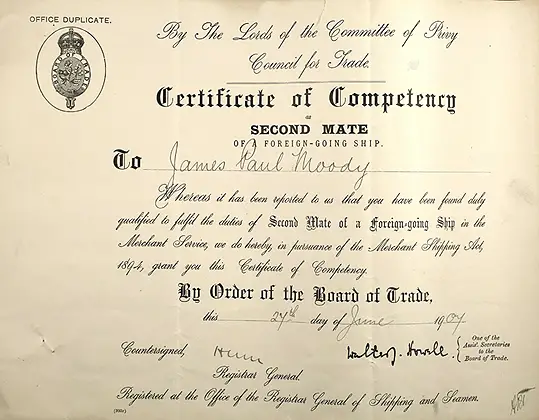
Moody's Second Mate BOT certificate, 1907.
(Click image to enlarge)
After passing his Second Mate’s certification in June 1907, Moody remained briefly with the Boadicea but now as second mate, from August 8th 1907 until Jan 22nd 1908, a total of 5 months and 16 days. Perhaps it was with a sense of relief he left the 'Boa', his home of four years, to make his transition to steam, as he wrote in a letter: ‘Don’t know where the Boa is going to get and don’t care if she goes where the Light Brigade charged either’. (1904 - 1912 correspondence of James Paul Moody.)
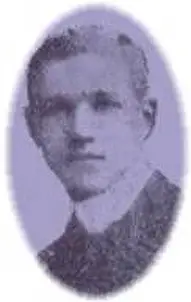
Undated image of James Moody.
(Inger Sheil/On Watch website)
Moody was now embarking on a career in steam, beginning with cargo and early oil-tankers. He first worked briefly aboard the SS Azov, as second mate for two weeks from January 22nd 1908 until February 5th, 1908. The Azov was a single screw steel tanker, built by Sir WG Armstrong, Mitchell & Co Ltd and owned by Azov Steamship Co Ltd (W Tapscott & Co), Liverpool . The ship was 2332grt and measured 285 x 38.5 x 25.9 feet (tynebuiltships.co.uk). At the time of Moody's service it was owned by the W. Keswick line of Liverpool (also known as "London & Pacific Petroleum Co") which was employed in "carrying petroleum in bulk" according to Lloyd's Register for 1908 (Lloyd's Register/Inger Sheil).
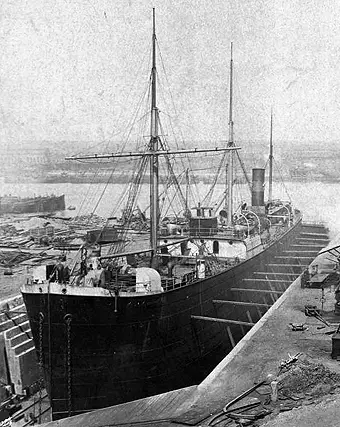
The SS Circassian Prince pictured in 1889.
(Image copyright: South Shields Libraries)
(Click to enlarge)
He then served aboard the SS Circassian Prince for the next 5 months, between the 5th of February 1908 until the 12th of July 1908. The Circassian Prince was a tanker, built in 1889 by C.S. Swan, Hunter & Co. at Wallsend with a tonnage of 2243grt, a length of 272ft 7in, a beam of 38ft 1in and a service speed of 10 knots. In 1902 she was sold to W. Keswick & Co. of London but maintained her port of registry as Newcastle and it is during this ownership that Moody worked aboard her.
He returned to the SS Azov as second mate on the 12th of July 1908 and worked aboard her for another 4 months, until November 11th, 1908.
According to Titanic researcher and author Inger Sheil, "Moody made several visits to Argentina prior to joining the White Star Line. He spent much of his career on the very early oil tankers and tramp steamers that worked the South American runs, and spent a lot of time in South American ports, including Argentinian locales. I recall him saying rather complimentary things about Argentina... he mentions "Buenos Ayres" (his preferred version of Buenos Aires). He compares it favourably to South Africa, believing it was a 'nicer' area. He also calls Beunos Aires a 'splendid city', and once spent ten days there late in 1908 on leave before sailing home to England - he met up with a friend and had a rather a good time, which resulted in a delay so he didn't get home in time for Christmas." (Encyclopaedia Titanica, message board)
South American ports proved to be something of an adventure: "In Chile he explored caves (‘creepy work!’), visited the beaches that rather daringly allowed mixed bathing ‘and other excitements’ and, preferring not to go ashore and drink to excess (the favoured occupation of his crewmates) sat on the ship and ate fresh fruit as he tallied the cargo brought aboard. Most of his career was to be spent in these South American ports - Iquique, Valparaiso, Gatico and the like - and he picked up some Spanish, regarding it as something of a point of pride that he could swear quite fluently in the language." ("On Watch" - Nautical-papers.com, 2002 by Jemma Hyder and Inger Sheil)
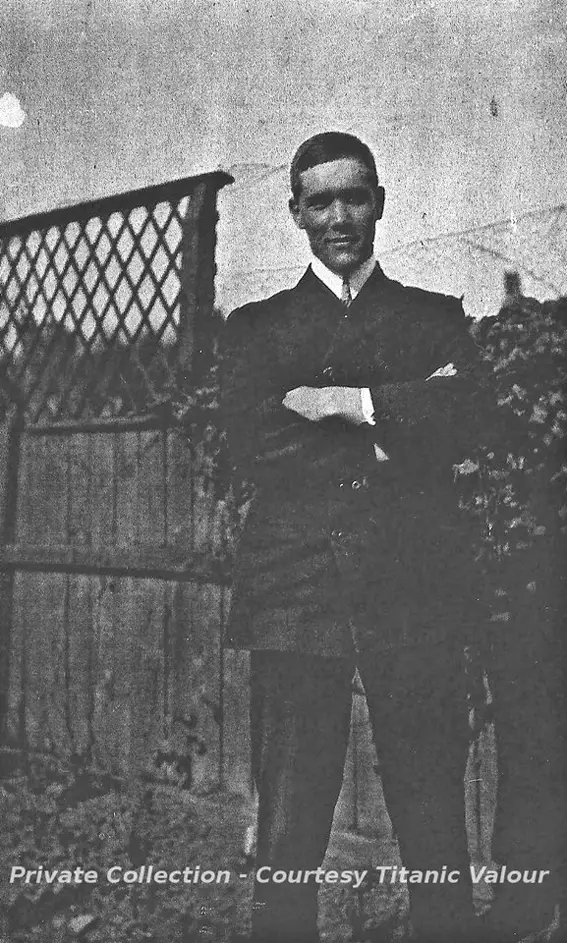
Undated image of James Moody in a suit. (Source: Titanic Valour/Inger Sheil)
Writing a Fictional Short Story
During his time in South America, between 1904 - 1909, James Moody also began writing an undated fictional short story featuring a hero by the name of "Brisco Fletters". According to researcher Inger Sheil, who came across fragments of the short story in his personal papers while writing an article regarding his Conway years, "the story draws on his experiences in South American ports" and that Moody was possibly considering the idea of submitting it for publication in one of the popular magazines at the time. Certainly he read these magazines - he refers to being given a stack of them when the Boadicea left New York, and mentions reading them in his bunk. The American characters suggest he might have had an American publication in mind. Whether he ever got so far as to complete or submit it to a magazine, I do not know… he was probably then still in his teens. His characterisations are sketchy, but he's good at narrative and has some rather good descriptions." (Encyclopaedia Titanica message board, March 9, 2009)
136 Fildes Street, Grimsby
By 1909, James Moody had moved from St James House to his own place which he shared with his older brother Christopher at 136 Fildes Street, Grimsby. It was on the urging of Christopher, with James writing that that now he was earning money "Chris and I are furnishing a tiny house near here as he has got such a dislike for lodgings and I want some little place to come home to." The exterior of the modest three bedroom terraced accommodation is presently covere in pebble dashing.

136 Fildes Street as it looked in 2020. (Photograph: Keith Wilson)
First Mate Certificate
On February 15th 1909, 22 year old James Moody applied for his first mate certificate in Liverpool, but then failed in "Navigation". Swiftly thereafter he applies again on the 19th of February and passes, with the certificate issued at the port of Grimsby to his updated address of 136 Fildes Street, Grimsby, on the 1st of March 1909.
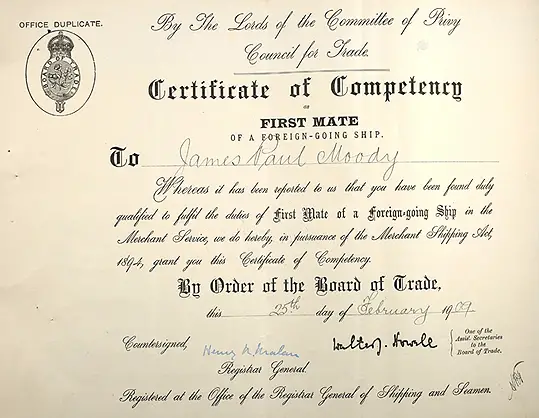
Moody's First Mate BOT certificate, 1909.
(Click image to enlarge)
One interesting aspect of the Board of Trade examinis that it also required the applicant to include a personal description, through which we gain an idea as to his physical characteristics: "Blue eyed and with light brown hair, by this time he had attained his full height of 5’11” and, although developing into a broad shouldered youth with a certain lithe athleticism, he was still very slimly built. The striking physical impression he left on his contemporaries is that of height and slenderness, the latter obviously accentuating the former. This was coupled with a meticulous attention to his personal grooming while ashore, leading one observer to comment on his ‘smart looking’ appearance." ("On Watch" - Nautical-papers.com, 2002 by Jemma Hyder and Inger Sheil)
His next vessel was the steamship S.S. Caprera, a Liverpool registered ship of 2197 tonnes, built in 1902 in Sunderland by the Short Brothers and owned by the British and Chilean Steamship Co. Ltd and aboard which he sailed on three foreign journeys. The first of which was from the 25th of May 1909 until the 26th of September 1909, a duration of 4 months and 3 days, where he was in the capacity of second mate. On the next voyage starting on the 27th September 1909 he is promoted to first officer for 2 months and 27 days, ending on the 23rd of December 1909.
The next year, 1910 he worked aboard the S.S. Caprera again, but is demoted back to second mate for the duration of one year 1 month and 22 days starting on the 18th of the first 1910 ending on the 8th of March 1911.
Also during 1910, Moody went after and received a commission with the Reserve as a Sub-Lieutenant.
Masters Certificate
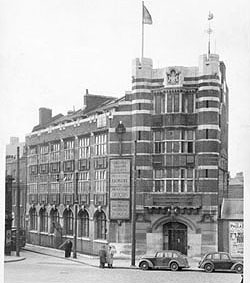
The King Edward VII Nautical School,
was a school for marine officers
located in the British Sailors' Society's
Residential Hostel for Marine Officers
(Commercial Road, London).
Perhaps frustrated at his one year demotion, James Moody briefly attended the King Edward VII Nautical School in London, a nautical "cram" school preparing officers for their Board of Trade examinations. Founded in 1902 by the British Sailors' Society. The Directors of the Society acted as the first governing body of the School, which was based over a seamen's hostel at 680 Commercial Road, Stepney, London.
While studying, he is listed as lodging at 37 Locksley Street, Limehouse, London. On the 10th of April 1911 he applied for his Masters certificate but failed again as he had on first mates application, on "Navigation." He reapplied eight days later to fail once again, but this time on the subject of "laws of storms." At a fee of £2 per application this was becoming expensive. But he persevered and on the 26th of April 1911 he passed and his Masters Certificate was issued at the Port of London, Dock Street on the 29th of April 1911. At the age of 23, James Moody was now certified as a master mariner.
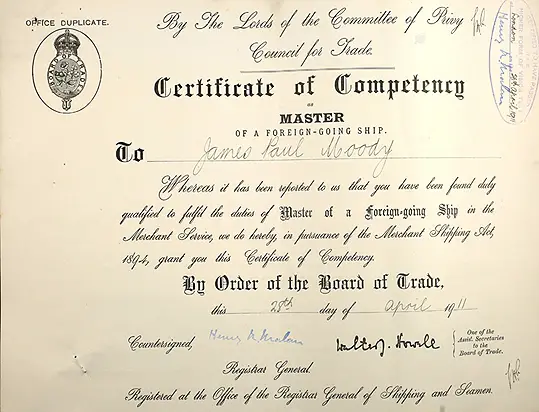
Moody's Masters BOT certificate, 1911.
(Click image to enlarge)
White Star Line
According to Bridge Duty, Officers of the RMS Titanic, "future prospects for the ambitious officer looked bright. The young Yorkshireman was ideal White Star material. Quite tall, and with a slender build and bearing that gave the impression of even greater height, he was noted for his impeccable grooming. 'A smart-looking young man' was one contemporary description. Photos confirm his meticulous appearance and handsome features, but also give a rather serious caste to his expression that is not reflected in the light playfulness of his private correspondence." (Bridge Duty, Officers of the RMS Titanic, Inger Sheil & Kerri Sundberg 1999)
On the 17th of August 1911 he joined the White Star Line, serving aboard the luxury liner, the SS Oceanic as her Sixth Officer. This was a prestigious ship for the 23 year old from Scarborough - he turned 24 just days after joining. Launched in 1899, the Oceanic was the largest ship in the world until 1901 and at 17,272 gross tonnes was 704 ft (215 m) long and 68.4 ft (20.8 m) wide, powered by triple expansion reciprocating engines equalling 28,000 horsepower. Lightoller had served aboard the Oceanic from 1907 to 1911, beginning as Second officer and then moving on to First, and spoke very highly of the ship:
“I got my severest mail boat training during the seven hard, though happy years I spent in the Queen of the Seas, as the Oceanic was then called. A wonderful ship, built in a class of her own, and by herself... She was an experiment, and a wonderfully successful one; built by Harland and Wolff, regardless of cost, elaborate to a degree, money lavished where it was necessary, but never gaudily as is so common nowadays.”(47.)
Lightoller served in the role of first officer until the 7th of December 1911, so he would undoubtedly have met the new sixth officer James Moody, who according to White Star Line records (below) worked as Sixth Officer from the 17th of August 1911 through to the 30th December 1911. Also, the role of fourth officer was filled by Herbert Pitman, who had joined on the 4th of August 1911.
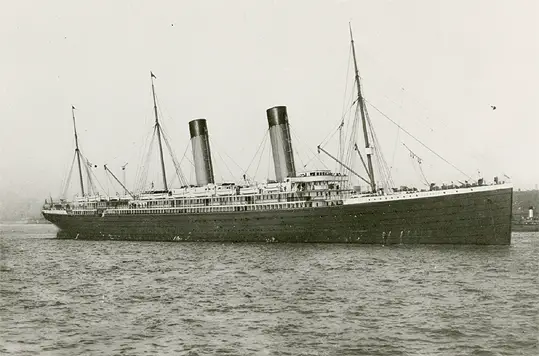
RMS Oceanic, aboard which Moody served as sixth officer.
(Click image to enlarge)
According to Titanic researcher Inger Sheil, "Moody had a high regard for Lightoller, considered [wireless operator Jack] Phillips to be 'a great pal', and mentions them both in his letters. He may also have enjoyed a good relationship with Pitman (his correspondence doesn't indicate either way)." (Encyclopedia Titanica, message board, Oct 16, 2003)
Moody apparently struck up a friendship with another officer - David Blair - although not aboard the Oceanic as they did not serve together at the same time aboard that ship. He apparently got to know the Blair family through his sister (according to David Blair's sister) and Blair "became something of a friend and mentor to the young man as he settled into the routine of trans-Atlantic voyages to New York."" (Bridge Duty, Officers of the RMS Titanic, Inger Sheil & Kerri Sundberg, 1999). Both Lightoller and Pitman were to become officers aboard the White Star Line's newest ship - Titanic. As was James Moody.
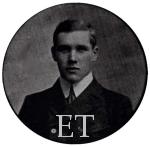
James Moody
(Source: Encyclopedia Titanica)
His time aboard the Oceanic under Captain Haddock also saw a promotion, as his record next lists him as Fifth Officer from the 30th of December through to the 26th of March 1912. Inger Sheil notes: "He'd already received one promotion on the Oceanic in the short spell he was on her, so he must have been showing a good deal of ability! I once saw a comment regarding Haddock that suggested that no man would receive a recommendation for promotion under him who did not show exemplary conduct and ability. That James Moody was first promoted under him on the Oceanic, then recommended for transferral to the Titanic, demonstrates that he was showing a good deal of talent. This is in spite of factors that weighed against him - he did not, for example, hold an extra-master's certificate." (Encyclopaedia Titanica message aboard, Jul 22, 2000)
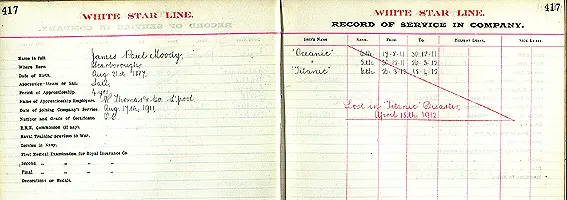
Moody's White Star Line record, revealing that he began working at the line on August 17th, 1911, and served aboard the Oceanic as 6th and 5th officer.
(Click image to enlarge)
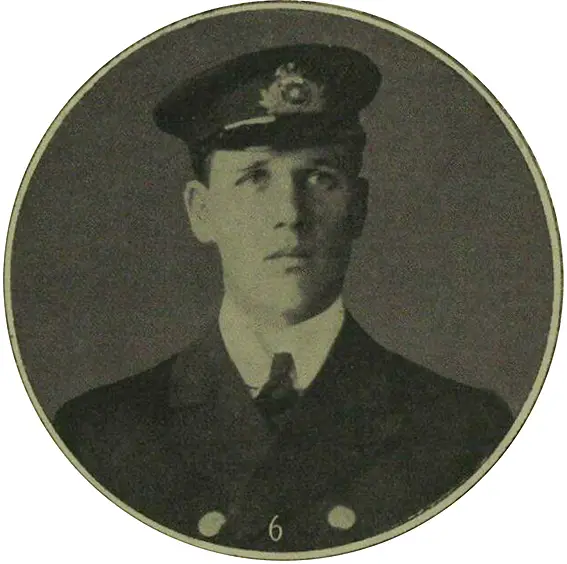
Illustrated London News
April 27 1912
Joining the White Star Line also prompted James to get his photograph taken in his new uniform - although he was disappointed in the result. He wrote in a letter accompanying the photograph: "I’m afraid it is very poor, but it is the best the camera could do with its difficult subject. So you must hang it in a poor light or else stow it away altogether. I will send two if you would care to have one each, but they are really so ugly that I don’t inflict them on more people than possible." (Moody, J. P., Correspondence, Private Collection, "On Watch" - Nautical-papers.com, 2002 by Jemma Hyder and Inger Sheil)
See also...
Next... Titanic